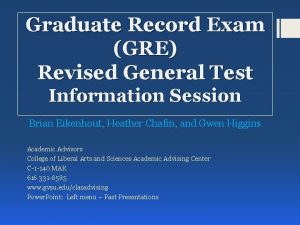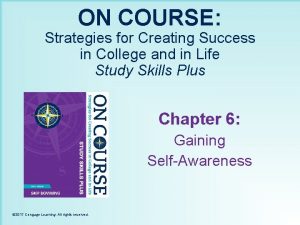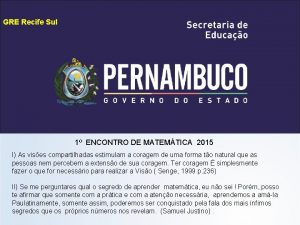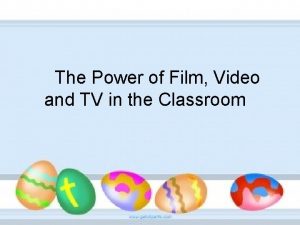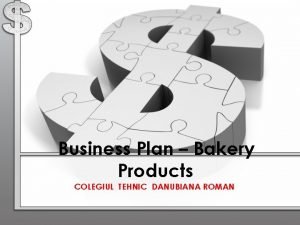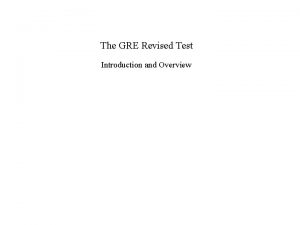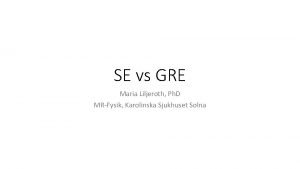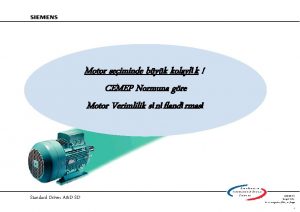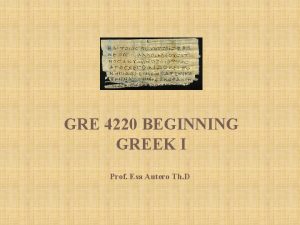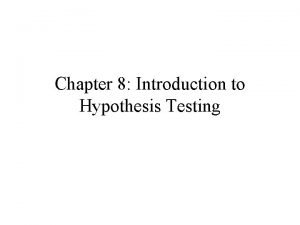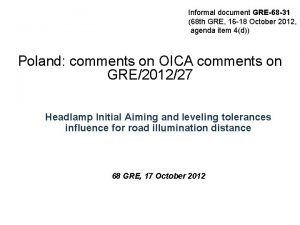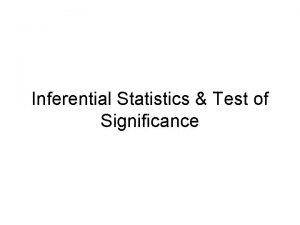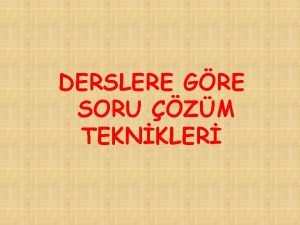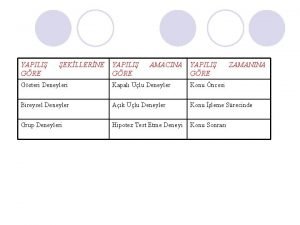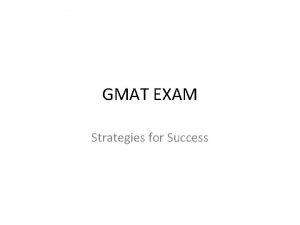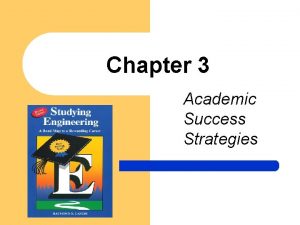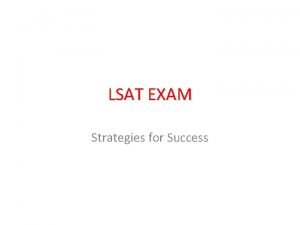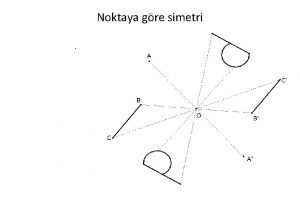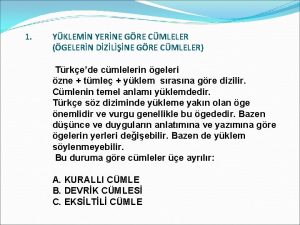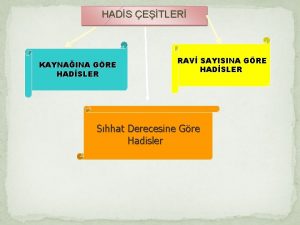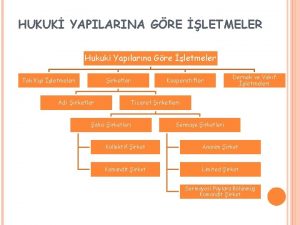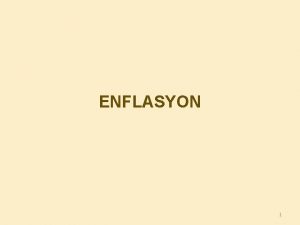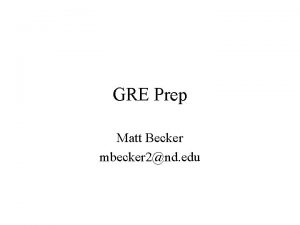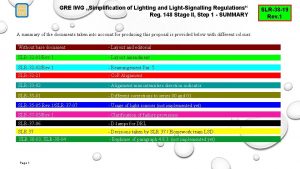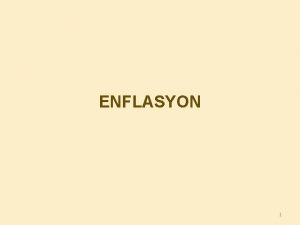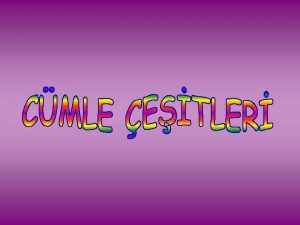GRE EXAM Strategies for Success GRE EXAM Structure

































































- Slides: 65

GRE EXAM Strategies for Success

GRE EXAM Structure of the Computer-Based Test • Analytical Writing: Writing one section with two essays – 30 minutes per essay; one hour total • Analyze an Issue • Analyze an Argument

Structure of the Computer-Based Test • Analytical Writing: one section with two essays • Verbal Reasoning: Reasoning two sections • Approximately 20 questions per section • 30 minutes per section

Structure of the Computer-Based Test • Analytical Writing: one section with two essays • Verbal Reasoning: two sections • Quantitative Reasoning: Reasoning two sections • Approximately 20 questions • 35 minutes per section

Structure of the Computer-Based Test • Analytical Writing: one section with two essays • Verbal Reasoning: two sections • Quantitative Reasoning: two sections • Unscored (varies) • Research (varies)

Structure of the Computer-Based Test • Summary: One 60 -minute essay-writing session. • Plus five 30 -or-35 -minute multiple-choice sections (only four sections count towards your score). • Total testing time of 3 hours 45 minutes, plus breaks, etc.

GRE Test Design Features • You may move forward and backward throughout any section • “Mark and Review” feature • You may change or edit answers within a section • Scoring is “Section-level adaptive” • On-screen calculator for Quantitative Reasoning • New answer formats

GRE Test Scoring • Analytical Writing: score between 0— 6; schools receive a copy of the two essays • Verbal Reasoning: scaled score between 130— 170 (mean 150) • Quantitative Reasoning: scaled score between 130— 170 (mean 150)

Reading Comprehension Introduction • HALF of the Verbal Reasoning questions are Reading Comprehension (10 out of 20) • About 6— 9 passages; about 50— 300 words; many are one paragraph, but some might be as long as five paragraphs • Expect 1— 4 questions per passage • Passages from physical sciences, biological sciences, social sciences, arts and humanities, everyday topics

Reading Comprehension Format The passage appears here, across the top of the page. The passage will remain on the screen until you have answered all questions. The first question related to this passage is HERE, across the middle of the page The answer choices are located HERE, near the bottom of the screen.

Reading Comp. Attack Strategy 1 st PRE-READ the question 2 nd READ the passage 3 rd RE-READ the question carefully 4 th ANALYZE the answer choices, eliminating wrong ones as you read

Strategies for Effective Reading 1. Read the passage ONCE. Avoid rereading at this time; get the content and overall point. How do I accomplish that?

Strategies for Effective Reading 1. Read the passage ONCE. Avoid rereading at this time; get the content, the author’s point(s). —READ ACTIVELY

Strategies for Effective Reading 1. Read the passage ONCE. Avoid rereading at this time; get the content, the author’s point(s). – READ ACTIVELY – VISUALIZE

Strategies for Effective Reading 1. Read the passage ONCE. Avoid rereading at this time; get the content, the author’s point(s). – READ ACTIVELY – VISUALLY – PARAPHRASE

Strategies for Effective Reading 1. Read the passage ONCE. Avoid rereading at this time; get the content, the author’s point(s). – READ ACTIVELY – VISUALLY – PARAPHRASE – ANALYZE

Strategies for Insightful Analysis • Distinguish main idea from supporting ideas. • Distinguish author’s personal ideas from mere reporting. • Distinguish hypothetical or speculative ideas from author’s committed ideas. • Identify transitions from one idea to another. • Identify the relationship between different ideas.

Strategies for R. C. Questions 1. Read the passage ONCE. 2. Do not apply outside knowledge to either the question or the passage.

Strategies for R. C. Questions 1. Read the passage ONCE. 2. Do not apply outside knowledge. 3. Read the questions carefully. Many wrong answers stem from misreading the question; know what is being asked.

Strategies for R. C. Questions 1. Read the passage ONCE. 2. Do not apply outside knowledge. 3. Read the questions carefully. Many wrong answers stem from misreading the question; know what is being asked. 4. Read each answer choice carefully; ONLY use the information in the passage.

Reading Comprehension Question Formats • Select Only One Answer Choice

Select Only One Answer: format • This is the most common set-up, the one you are most familiar with: one question, five answer choices. • Most Reading Comprehension questions follow this format.

Select Only One Answer: format The passage appears here, across the top of the page. The question will be printed here. Sample: “The author would agree with which of the following? ” The answer choices appear here. o o o Choice #1 Choice #2 Choice #3 Choice #4 Choice #5 Simply click on the one correct choice.

Select Only One Answer: Strategies • Read ALL five of the answer choices; eliminate wrong ones as you go. • Be sure to read the question carefully. • Correct response = most accurately and completely answers the specific question. • When asked about vocabulary, use passage context and content.

Sample Questions 1 – 3 are based on the following passage: Roses are red. Violets are blue. Sugar is sweet. And so are you.

Roses are red. Violets are blue. Sugar is sweet. And so are you. Sample Reading Comprehension Question #1 Five Options, Select Only One #1. According to the passage, what color are roses? o o o Blue. Green. Yellow. Red. Sweet. Answer: The 4 th Option: Roses are red.

Reading Comprehension Question Formats • Select Only One Answer Choice • Select One or More Answer Choices

Select One or More Questions • These questions mimic the old “multiple choice” questions, the ones you loved to hate! • They were frustrating and time consuming.

Select One or More: old format The “multiple-multiple choice” old format had a question here, followed by three options: I. First potential option II. Second potential option III. Third potential option Then, you had to choose from five answers. A. I only D. II and III only B. II only E. I, II, and III C. I and III only

Select One or More: new format The passage appears here, across the top of the page. The directions will read “For the following question, consider each choice separately and select all that apply. ” The author suggests that…is true in which of the following respects? q First potential option. q Second potential option. q Third potential option. You simply click on each correct option. Viola!

Select One or More Answer Strategies • Three choices; select ALL correct responses for credit. No partial credit. • Evaluate each answer option independently. • Correct response(s) most accurately and completely answer the question. • All three answers may be correct; do not be misled.

Roses are red. Violets are blue. Sugar is sweet. And so are you. Sample Reading Comprehension Question #2 Three Options, Select All Correct Choices “Consider each of the three choices separately and select all that apply. ” #2. Based on the facts presented in the passage, which of the following must be true? q Roses are red. q Blue was the color of all the Violets that were included in this sample. q If any substance is sweet, it must be sugar. Answer: The first two options are both true; Roses are red and Violets are blue. However, the 3 rd Option is false; the passage states that sugar is sweet, but it does not state the inverse, that all sweet things are sugar.

Reading Comprehension Question Formats • Select Only One Answer Choice • Select One or More Answer Choices • Select-In-Passage

Select-In-Passage Questions • These questions mimic the old “our answer choices will repeat five quotations from the text and you choose the one that answers our question. ” • This format was very time consuming.

Select-In-Passage: old format A question would be printed here, such as “Which of the following best clarifies the author’s point about…. ” Followed by five answer choices, all quotations from the text. You chose the one that best answered the question. A. “……. . ” D. “……. . ” B. “……. . ” E. “……. . ” C. “……. . ”

Select-In-Passage: new format The passage appears here, across the top of the page. The question will read “Select a sentence in the passage that…. ” The author suggests that…is true in which of the following respects? q First potential option. q Second potential option. q Third potential option. You simply click on each correct option. Viola!

Select-In-Passage: Strategies • Select the one sentence that best answers the question; placing the cursor anywhere in sentence will highlight it. • Evaluate each of the relevant sentences in the designated paragraph. • Correct sentence = most accurately matches the task in the question.

Roses are red. Violets are blue. Sugar is sweet. And so are you. Sample RC Question #3: Select-In-Passage Question: #3. Select the sentence in the passage that identifies the flavor sensation caused by the presence of sugar.

Roses are red. Violets are blue. Sugar is sweet. And so are you. Sample Select-In-Passage Question: #3. Select the sentence in the passage that identifies the flavor sensation caused by the presence of sugar. Answer: The correct answer is line 3, Sugar is sweet.

Reading Comprehension Question Categories 1. Main Idea

Reading Comprehension Question Categories 1. Main Idea 2. Supporting Idea

Reading Comprehension Question Categories 1. Main Idea 2. Supporting Idea 3. Implications / Inferences

Reading Comprehension Question Accessibility • Know how to access the accurate answer; questions are written in three levels: – FACTUAL QUESTIONS

Reading Comprehension Question Accessibility • Know how to access the accurate answer; questions are written in three levels: – FACTUAL QUESTIONS – MAIN IDEA QUESTIONS

Reading Comprehension Question Accessibility • Know how to access the accurate answer; questions are written in three levels: – FACTUAL QUESTIONS – MAIN IDEA QUESTIONS – HIDDEN IDEA QUESTIONS

Reading Comprehension Eliminating Wrong Answers To eliminate incorrect answer choices, look for: KEY Key words misstated or key ideas twisted (contradicts passage)

Reading Comprehension Eliminating Wrong Answers To eliminate incorrect answer choices, look for: KEY: Key words misstated or key ideas twisted Reversals: Reversals Answer leads in opposite direction (e. g. weakening instead of strengthening)

Reading Comprehension Eliminating Wrong Answers To eliminate incorrect answer choices, look for: KEY: Key words misstated or key ideas twisted Reversals: Answer leads in opposite direction N/A: N/A Answer brings up info that is not addressed (i. e. answer has outside information)

Reading Comprehension Eliminating Wrong Answers To eliminate incorrect answer choices, look for: KEY: Key words misstated or key ideas twisted Reversals: Answer leads in opposite direction N/A: Answer brings up info that is not addressed Irr. : Irr. Answer is irrelevant to this question (answer may be true, but not for this question)

Reading Comprehension Eliminating Wrong Answers To eliminate incorrect answer choices, look for: KEY: Key words misstated or key ideas twisted Reversals: Answer leads in opposite direction N/A: Answer brings up info that is not addressed Irr. : Answer is irrelevant to this question Too General/Too Specific: Specific Answer not the right size

Reading Comprehension Eliminating Wrong Answers To eliminate incorrect answer choices, look for: KEY: Key words misstated or key ideas twisted Reversals: Answer leads in opposite direction N/A: Answer brings up info that is not addressed Irr. : Answer is irrelevant to this question Too General/Too Specific: Answer not right size Qualifiers: Qualifiers Answer uses wrong qualifying words.

Reading Comprehension Eliminating Wrong Answers To eliminate incorrect answer choices, look for: KEY: Key words misstated or key ideas twisted Reversals: Answer leads in opposite direction N/A: Answer brings up info that is not addressed Irr. : Answer is irrelevant to this question Too General/Too Specific: Answer not right size Qualifiers: Answer uses wrong qualifying words Absolutes: Absolutes Answer uses words that are too strong

Reading Comprehension Eliminating Wrong Answers To eliminate incorrect answer choices, look for: KEY: Key words misstated or key ideas twisted Reversals: Answer leads in opposite direction N/A: Answer brings up info that is not addressed Irr. : Answer is irrelevant to this question Too General/Too Specific: Answer not right size Qualifiers: Answer uses wrong qualifying words Absolutes: Answer uses words that are too strong Unreasonable: Unreasonable Answer just feels wrong

Reading Comprehension Practice Test Questions and Review

Text Completion Introduction • About 6 questions (out of 20 Verbal Reasoning questions) • One or more sentences with 1, 2, or 3 blanks to fill in – One blank = five answer choices – Two or three blanks = three options per blank • Must choose ALL accurate answers for any credit; no partial credit

Text Completion Strategies • Read the passage to get an overall sense of it. • Identify significant words or phrases. • Think of words you’d use to complete the blanks. • Do not assume the first blank should be filled in first. • Check for logical, grammatical, and stylistic coherence. • Consider positive and/or negative connotation.

Sample Text Completion Question #1 Single Blank, 5 Choices #1. From the outset, the concept of freedom of the seas from the proprietary claims of nations was challenged by a contrary notion — that of the _______ of the oceans for reasons of national security and profit. Answer Choices for Question #1: promotion exploration surveying conservation appropriation Answer: appropriation

Sample Text Completion Question #2 2 Blanks, 3 Choices Each #2. Vain and prone to violence, Caravaggio could not handle success: the more his (1)_____ as an artist increased, the more (2)_____ his life became. Answer choices for Question 2: Blank (1) Blank (2) temperance tumultuous notoriety providential eminence dispassionate Answer: eminence and tumultuous

Text Completion • Practice Test Questions and Review

Sentence Equivalence Introduction • About 4 out of 20 Verbal Reasoning questions • One sentence with only one blank • SIX answer choices; chose TWO that can each complete the sentence • No partial credit; you must select both correct words

Sentence Equivalence Strategies • Read the sentence to get an overall sense of it. • Identify significant words or phrases that emphasize structure or overall meaning. • Think of a word you’d use then look for equivalents, but don’t become fixated. • Make sure each word fits and that each resulting sentence has the same meaning.

Sample Sentence Equivalence Question #1 Just 1 Blank, but 2 “Equivalent” Choices #1. Although it does contain some pioneering ideas, one would hardly characterize the work as _____. Answer choices for question 1: q q q orthodox eccentric original trifling conventional innovative Answer: original and innovative

Sentence Equivalence • Practice Test Questions and Review

GRE Prep - Review • Review Question Types • Review Question Formats • Review Attack Strategies • Review Elimination Tools • Practice, PRACTICE!

You Can Do It! GOOD LUCK ON THE GRE EXAM!
 Gre exam
Gre exam Gre exam
Gre exam Your child's success or lack of success
Your child's success or lack of success Your child's success or lack of success
Your child's success or lack of success Inner defender examples
Inner defender examples On course strategies for creating success in college
On course strategies for creating success in college Prayer to joseph of cupertino
Prayer to joseph of cupertino Prayer for final exams
Prayer for final exams Coping strategies for exam stress
Coping strategies for exam stress Iz zemlje gre v trto
Iz zemlje gre v trto A figura representada abaixo é de um prisma com x faces
A figura representada abaixo é de um prisma com x faces The power of film video and tv in the classroom
The power of film video and tv in the classroom Quantitative comparison gre
Quantitative comparison gre Danubiana roman
Danubiana roman Post gre sql
Post gre sql Gre
Gre Maria gre
Maria gre Peter gre
Peter gre Gre benefits
Gre benefits Motor gre
Motor gre I prof gre
I prof gre Gre elaboration
Gre elaboration Kaplan gre
Kaplan gre Gre
Gre Difference of t distribution and normal distribution
Difference of t distribution and normal distribution Cem yurtsev
Cem yurtsev Gre sınav soruları
Gre sınav soruları Fspos
Fspos Typiska novell drag
Typiska novell drag Tack för att ni lyssnade bild
Tack för att ni lyssnade bild Vad står k.r.å.k.a.n för
Vad står k.r.å.k.a.n för Shingelfrisyren
Shingelfrisyren En lathund för arbete med kontinuitetshantering
En lathund för arbete med kontinuitetshantering Särskild löneskatt för pensionskostnader
Särskild löneskatt för pensionskostnader Personlig tidbok fylla i
Personlig tidbok fylla i Sura för anatom
Sura för anatom Densitet vatten
Densitet vatten Datorkunskap för nybörjare
Datorkunskap för nybörjare Tack för att ni lyssnade bild
Tack för att ni lyssnade bild Debatt artikel mall
Debatt artikel mall Delegerande ledarskap
Delegerande ledarskap Nyckelkompetenser för livslångt lärande
Nyckelkompetenser för livslångt lärande Påbyggnader för flakfordon
Påbyggnader för flakfordon Lufttryck formel
Lufttryck formel Offentlig förvaltning
Offentlig förvaltning Urban torhamn
Urban torhamn Presentera för publik crossboss
Presentera för publik crossboss Argument för teckenspråk som minoritetsspråk
Argument för teckenspråk som minoritetsspråk Plats för toran ark
Plats för toran ark Klassificeringsstruktur för kommunala verksamheter
Klassificeringsstruktur för kommunala verksamheter Luftstrupen för medicinare
Luftstrupen för medicinare Bästa kameran för astrofoto
Bästa kameran för astrofoto Cks
Cks Programskede byggprocessen
Programskede byggprocessen Mat för idrottare
Mat för idrottare Verktyg för automatisering av utbetalningar
Verktyg för automatisering av utbetalningar Rutin för avvikelsehantering
Rutin för avvikelsehantering Smärtskolan kunskap för livet
Smärtskolan kunskap för livet Ministerstyre för och nackdelar
Ministerstyre för och nackdelar Tack för att ni har lyssnat
Tack för att ni har lyssnat Referatmarkering
Referatmarkering Redogör för vad psykologi är
Redogör för vad psykologi är Matematisk modellering eksempel
Matematisk modellering eksempel Atmosfr
Atmosfr Borra hål för knoppar
Borra hål för knoppar Orubbliga rättigheter
Orubbliga rättigheter

